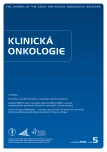Pregnancy and Ovarian Stimulation in the Patients with Breast Cancer
Authors:
Dostálek Lukáš; Pavlišta David; Mašata Jaromír
Authors‘ workplace:
Gynekologicko-porodnická klinika 1. LF UK a VFN v Praze
Published in:
Klin Onkol 2018; 31(5): 325-329
Category:
Review
doi:
https://doi.org/10.14735/amko2018325
Overview
Background:
Total 19% of patients diagnosed with breast cancer are younger than 50 years. Many of these patients will have postponed pregnancy into later life and many clinicians, who take care of these patients with mutations in tumor-suppressor genes, such as BRCA2, BRCA1, CHEK2, and others, recommend that it is better not to have a child than take the risk of developing a relapse. However, this recommendation can significantly reduce quality of life.
Aim:
The purpose of this article was to answer the most common questions that clinicians are confronted with when dealing with breast cancer patients who express a desire to have a child later in life. Is gravidity affected by breast carcinoma treatment? How does chemotherapy compromise my child-bearing potential? Can I undergo some of the methods of assisted reproduction? Is it possible to preserve my fertility before the start of oncological treatment?
Conclusions:
The results of meta-analysis have shown that pregnancy after the end of breast carcinoma treatment is safe. However, chemotherapy reduces fertility. Safe stimulation protocols that do not raise the risk of relapse and that can be off ered during the course of treatment are available.
Key words:
breast neoplasms – fertility – pregnancy – reproduction
The authors declare they have no potential conflicts of interest concerning drugs, products, or services used in the study.
The Editorial Board declares that the manuscript met the ICMJE recommendation for biomedical papers.
Submitted: 8. 4. 2018
Accepted: 13. 8. 2018
Sources
1. Dušek L, Mužík J, Kubásek M et al. Epidemiologie zhoubných nádorů v České republice. [online]. Dostupné z: www.svod.cz..
2. Duffy C, Allen S. Medical and psychosocial aspects of fertility after cancer. Cancer J 2009; 15 (1): 27–33. doi: 10.1097/PPO.0b013e3181976602.
3. Valachis A, Tsali L, Pesce LL et al. Safety of pregnancy after primary breast carcinoma in young women: a meta-analysis to overcome bias of healthy mother effect studies. Obstet Gynecol Surv 2010; 65 (12): 786–793. doi: 10.1097/OGX.0b013e31821285bf.
4. Azim HA Jr, Santoro L, Pavlidis N et al. Safety of pregnancy following breast cancer diagnosis: a meta-analysis of 14 studies. Eur J Cancer 2011; 47 (1): 74–83. doi: 10.1016/j.ejca.2010.09.007.
5. Ives A, Saunders C, Bulsara M et al. Pregnancy after breast cancer: population based study. BMJ 2007; 334 (7586): 194. doi: 10.1136/bmj.39035.667176.55.
6. Goodwin PJ, Ennis M, Pritchard KI et al. Risk of menopause during the first year after breast cancer diagnosis. J Clin Oncol 1999; 17 (8): 2365–2370. doi: 10.1200/ JCO.1999.17.8.2365.
7. Oktay K, Buyuk E, Davis O et al. Fertility preservation in breast cancer patients: IVF and embryo cryopreservation after ovarian stimulation with tamoxifen. Hum Reprod 2003; 18 (1): 90–95.
8. Oktay K, Buyuk E, Libertella N et al. Fertility preservation in breast cancer patients: a prospective controlled comparison of ovarian stimulation with tamoxifen and letrozole for embryo cryopreservation. J Clin Oncol 2005; 23 (19): 4347–4353. doi: 10.1200/JCO.2005.05. 037.
9. Azim AA, Costantini-Ferrando M, Lostritto K et al. Relative potencies of anastrozole and letrozole to suppress estradiol in breast cancer patients undergoing ovarian stimulation before in vitro fertilization. J Clin Endocrinol Metab 2007; 92 (6): 2197–2200. doi: 10.1210/jc.2007-0247.
10. Azim AA, Costantini-Ferrando M, Oktay K. Safety of fertility preservation by ovarian stimulation with letrozole and gonadotropins in patients with breast cancer: a prospective controlled study. J Clin Oncol 2008; 26 (16): 2630–2635. doi: 10.1200/JCO.2007.14.8700.
11. Meirow D, Epstein M, Lewis H et al. Administration of cyclophosphamide at different stages of follicular maturation in mice: effects on reproductive performance and fetal malformations. Hum Reprod 2001; 16 (4): 632–637.
12. Del Mastro L, Catzeddu T, Boni L et al. Prevention of chemotherapy-induced menopause by temporary ovarian suppression with goserelin in young, early breast cancer patients. Ann Oncol 2006; 17 (1): 74–78. doi: 10.1093/annonc/mdj029.
13. Lambertini M, Moore HCF, Leonard RCF et al. Gonadotropin-releasing hormone agonists during chemotherapy for preservation of ovarian function and fertility in premenopausal patients with early breast cancer: a systematic review and meta-analysis of individual patient-level data. J Clin Oncol 2018; 36 (19): 1981–1990. doi: 10.1200/JCO.2018.78.0858.
14. Hershman DL, Shao T, Kushi LH et al. Early discontinuation and non-adherence to adjuvant hormonal therapy are associated with increased mortality in women with breast cancer. Breast Cancer Res Treat 2011; 126 (2): 529–537. doi: 10.1007/s10549-010-1132-4.
15. Langagergaard V, Gislum M, Skriver MV et al. Birth outcome in women with breast cancer. Br J Cancer 2006; 94 (1): 142–146. doi: 10.1038/sj.bjc.6602878.
16. Dalberg K, Eriksson J, Holmberg L. Birth outcome in women with previously treated breast cancer – a population-based cohort study from Sweden. PLoS Med 2006; 3 (9): e336. doi: 10.1371/journal.pmed.0030336.
17. Weinberger V, Zikán M. Karcinom prsu – specifika gynekologické péče a poradenství. Klin Onkol 2016; 29 (Suppl 3): S7–S15. doi: 10.14735/amko20163S7.
18. Titus S, Li F, Stobezki R et al. Impairment of BRCA1-related DNA double-strand break repair leads to ovarian aging in mice and humans. Sci Transl Med 2013; 5 (172): 172ra21. doi: 10.1126/scitranslmed.3004 925.
19. Valentini A, Finch A, Lubinski J et al. Chemotherapy-induced amenorrhea in patients with breast cancer with a BRCA1 or BRCA2 mutation. J Clin Oncol 2013; 31 (31): 3914–3919. doi: 10.1200/JCO.2012.47. 7893.
20. Valentini A, Lubinski J, Byrski T et al. The impact of pregnancy on breast cancer survival in women who carry a BRCA1 or BRCA2 mutation. Breast Cancer Res Treat 2013; 142 (1): 177–185. doi: 10.1007/s10549-013-27 29-1.
Labels
Paediatric clinical oncology Surgery Clinical oncologyArticle was published in
Clinical Oncology

2018 Issue 5
Most read in this issue
- Solid Pseudopapillary Tumor of the Pancreas – Rare Neoplastic Disease in 20-Year-Old Woman
- Psychoneuroimmunology of Cancer – Recent Findings and Perspectives
- The Significance of BRAFV600E Mutation in Thyroid Cancer in Terms of Novel Targeted Therapies – Overview of Current Knowledge and Studies
- Pregnancy and Ovarian Stimulation in the Patients with Breast Cancer
